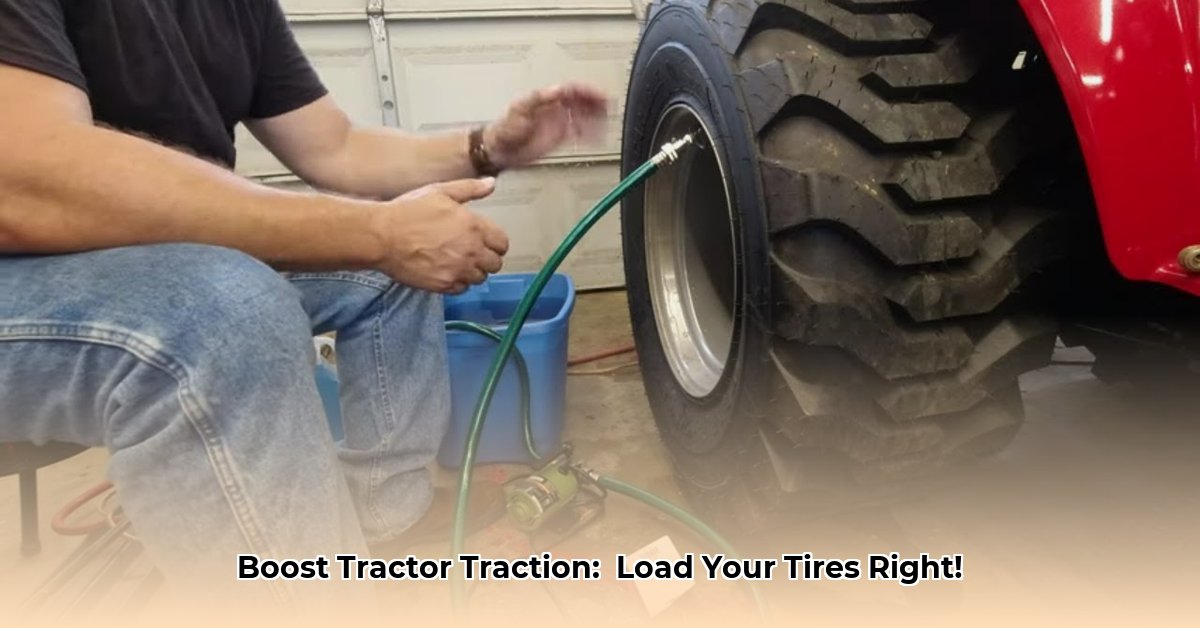
Adding ballast to your tractor tires significantly improves traction, stability, and overall performance, especially in challenging field conditions. This comprehensive guide provides step-by-step instructions for various ballasting methods, emphasizing safety and environmental responsibility. We'll explore traditional methods alongside environmentally friendly alternatives, ensuring you can choose the best approach for your farm and its unique circumstances. For more information on tire performance, check out Nokian Tyres.
Methods for Ballasting Tractor Tires
Several options exist for ballasting tractor tires, each with advantages and disadvantages concerning cost, effectiveness, environmental impact, and ease of use.
Traditional Methods: Water and Calcium Chloride
Water: Water is a readily available and inexpensive ballast. Its ease of use makes it a popular choice among farmers.
- Pros: Low cost, readily available, easy to add and remove.
- Cons: Susceptible to freezing, leading to potential tire damage in colder climates. Heavier than other options, requiring more frequent refilling and potentially increasing wear and tear on the equipment.
Calcium Chloride: This offers better cold-weather performance compared to water.
- Pros: Doesn't freeze, providing consistent ballast, offers superior weight distribution compared to water.
- Cons: Corrosive, posing risks to tires and the environment if not handled and disposed of properly. More expensive than water and requires careful handling.
The Dangers of Using Windshield Washer Fluid
Using windshield washer fluid as ballast is strongly discouraged. It presents significant environmental and safety risks. The short-term cost savings are far outweighed by the potential for long-term tire damage and severe environmental consequences. The chemical composition can harm both the environment and potentially damage your tires.
Sustainable Alternatives: Environmentally Responsible Ballasting
Several sustainable alternatives minimize environmental impact while providing effective ballast.
- Recycled Rubber Granules: Offer excellent ballast properties and are environmentally friendly due to their recycled nature.
- Clean, Dry Sand: A readily available option in many areas, although its effectiveness might be lower than other options like calcium chloride. Requires careful consideration concerning potential for leakage, and tire degradation.
- Beet Juice Solutions (e.g., Rim Guard): Biodegradable and non-toxic, these solutions represent a significant advancement toward sustainable ballasting practices. While more expensive than water, the environmental benefits often outweigh the additional cost.
Step-by-Step Guide: Adding Water Ballast
This section details the process of adding water ballast, a common and relatively simple method. Always prioritize safety and refer to your tire manufacturer's specifications.
Step 1: Preparation: Clean the tire and valve area thoroughly. Gather necessary tools: valve core removal tool, pressure gauge, garden hose with nozzle. Wear safety glasses and gloves.
Step 2: Valve Core Removal: Carefully remove the valve core using the appropriate tool.
Step 3: Filling the Tire: Slowly fill the tire with water, monitoring the pressure with a gauge. Never exceed the manufacturer's recommended maximum pressure.
Step 4: Valve Core Replacement: Securely replace the valve core.
Step 5: Final Pressure Check: Verify the tire pressure using the gauge. Ensure it falls within the manufacturer's specifications.
Safety Precautions
Safety is paramount. Always:
- Wear safety glasses and gloves.
- Use proper lifting techniques for heavy objects.
- Never exceed the maximum recommended tire pressure.
- Dispose of ballast materials responsibly, following local environmental regulations.
Disposal and Environmental Considerations
Proper disposal of ballast materials is crucial. Water usually requires minimal disposal effort, but ensure that any runoff does not negatively impact water sources. Calcium chloride needs specialized disposal as it's corrosive. Always abide by local regulations and consider using environmentally friendly alternatives to minimize environmental impact.
Troubleshooting
Leaks necessitate tire and valve inspection, repairing or replacing as needed. Consult a tire professional for assistance. If tires feel unbalanced, adjust ballast distribution. Refer to your tractor's manual or a qualified professional for other issues.
Conclusion: Balancing Efficiency and Sustainability
Choosing the most suitable ballasting method requires careful consideration of cost, effectiveness, and environmental impact. Prioritize safety and adhere to all local regulations. Using sustainable practices safeguards both your equipment and the environment. Further research, guided by your specific needs and local regulations, will aid in optimizing your ballasting strategy. Remember, responsible farming practices ensure long-term success and sustainability.